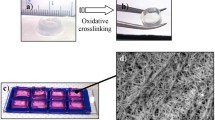Abstract
Hydrogel dressings are routinely used in the treatment of superficial skin wounds. Due to their excellent transparency, we decided to evaluate their usefulness in laser-based medical procedures. We focused on assessing selected physical properties of HydroAid hydrogel wound dressing, used for low-level laser therapy (LLLT) aka laser biostimulation procedures. For the two wavelengths of 660 and 808 nm used in the biostimulation laser POLARIS 2, a dressing transmittance of 92 and 98%, respectively, was determined. Using a FLIR i7 thermal imaging camera, the changes in temperature distribution across the surface of the dressing were assessed, during a 3-h period following its unpacking and placing on the skin of a patient or leaving it at the ambient temperature. The results of the thermal imaging, as well as temperature measurements using a digital thermometer, showed that the cooling properties of a hydrogel dressing were maintained throughout the entire experiment and that it was capable to keep the temperature at least 5° below the skin/ambient (room) temperature. During the 6-h observation using the holographic microscope, which provided indirect insight into the processes occurring within the hydrogel, only minimum topographical changes (observable at a micrometre scale) were recorded, although dressing thickness and its flexibility decreased significantly with time. Additionally, the possibility to regenerate the hydrogel dressing by treating it with distilled water or a physiological salt solution was tested.





Similar content being viewed by others
References
Goodwin NS, Spinks A, Wasiak J (2016) The efficacy of hydrogel dressings as a first aid measure for burn wound management in the pre-hospital setting: a systematic review of the literature. Int Wound J 13(4):519–525
Dumville JC, Stubbs N, Keogh SJ, Walker RM, Liu Z. (2015) Hydrogel dressings for treating pressure ulcers. Cochrane Database Syst Rev Feb 17:(2)
Saco M, Howe N, Nathoo R, Cherpelis B. (2016) Comparing the efficiencies of alginate, foam, hydrocolloid, hydrofiber, and hydrogel dressings in the management of diabetic foot ulcers and venous leg ulcers: a systematic review and meta-analysis examining how to dress for success. Dermatol Online J 15:22(8)
Bialik-Wąs K, Pielichowski K (2011) Polimerowe opatrunki hydrożelowe dla zastosowań biomedycznych. Czasopismo Techniczne, Wydawnictwo Politechniki Krakowskiej 10
Wathoni N, Motoyama K, Higashi T, Okajima M, Kaneko T, Arima H (2016) Physically crosslinked-sacran hydrogel films for wound dressing application. Int J Biol Macromol 89:465–470
He H, Xia D-L, Chen Y-P, Li X-D, Chen C, Wang Y-F, Shen L, Hu Y-L, Gu H-Y (2015) Evaluation of a two-stage antibacterial hydrogel dressing for healing in an infected diabetic wound. J Biomed Mater Res Part B 2015:00B
Babavalian H, Latifi AM, Shokrgozar MA, Bonakdar S, Mohammadi S, Moosazadeh Moghaddam M (2015) Analysis of healing effect of alginate sulfate hydrogel dressing containing antimicrobial peptide on wound infection caused by methicillin-resistant Staphylococcus aureus. Jundishapur J Microbiol 9:7–8
Lin YH, Lin JH, Li TS, Wang SH, Yao CH, Chung WY, Ko TH (2016) Dressing with epigallocatechin gallate nanoparticles for wound regeneration. Wound Repair Regen 24(2):287–301
Browning MB, Cereceres SN, Luong PT, Cosgriff-Hernandez EM (2014) Drying and storage effects on poly(ethylene glycol) hydrogel mechanical properties and bioactivity. J Biomed Mater Res Part A 102(9):3066–3076
Murphy SV, Skardal A, Atala A (2013) Evaluation of hydrogels for bio-printing applications. Evaluation of hydrogels for bio-printing applications. J Biomed Mater Res Part A 101A:272–284
Gil-Cazorla R, Teus MA, Hernández-Verdejo JL, De Benito-Llopis L, Garcia-González M (2008) Comparative study of two silicone hydrogel contact lenses used as bandage contact lenses after LASEK. Optom Vis Sci 85(9):884–888
Goldman MP, Roberts TL, Skover G, Lettieri JT, Fitzpatrick RE (2002) Optimizing wound healing in the face after laser abrasion. J Am Acad Dermatol 46(3):399–407
Bodendorf MO, Grunewald S, Simon JC, Paasch U (2008) Efficacy and cosmetic results of contact gel cooling of the skin during non-ablative laser procedures. J Dtsch Dermatol Ges 6(8):647–652
Newman JP, Koch RJ, Goode RL (1998) Closed dressings after laser skin resurfacing. Arch Otolaryngol Head Neck Surg 124(7):751–757
Funding
No special funding.
Author information
Authors and Affiliations
Corresponding author
Ethics declarations
Conflict of interest
The authors declare that they have no conflict of interest.
Ethical approval
Approval by Ethical Commission is not needed.
Informed consent
Not applicable since there are no patients involved.
Rights and permissions
About this article
Cite this article
Wachal, K., Stachowska, E., Korpuścińska, K. et al. Physical properties of hydrogel wound dressing and its use in low-level laser therapy (LLLT). Lasers Med Sci 33, 1317–1325 (2018). https://doi.org/10.1007/s10103-018-2484-y
Received:
Accepted:
Published:
Issue Date:
DOI: https://doi.org/10.1007/s10103-018-2484-y




